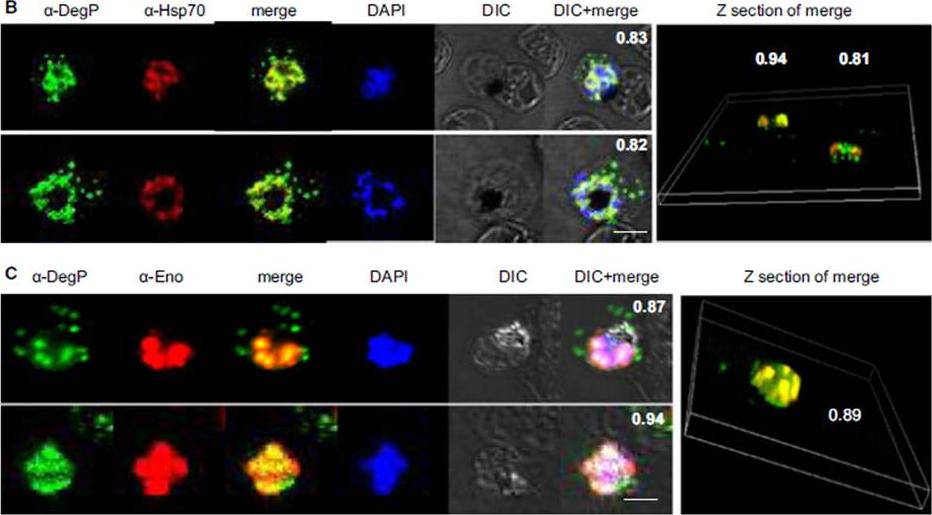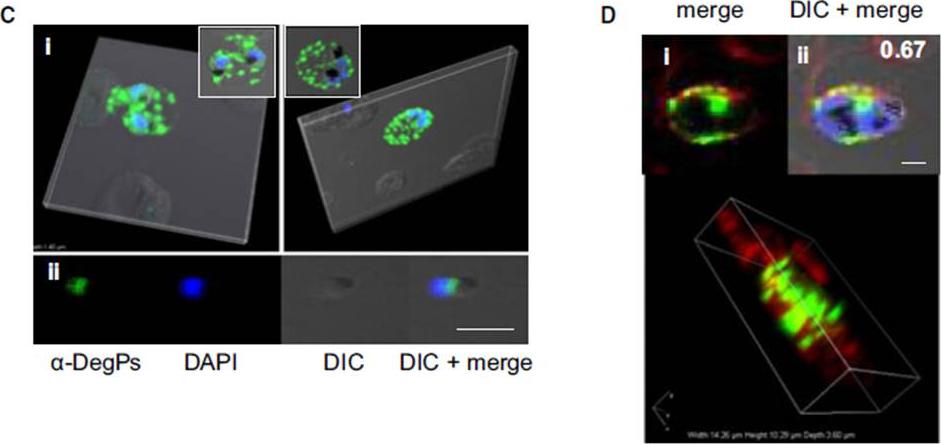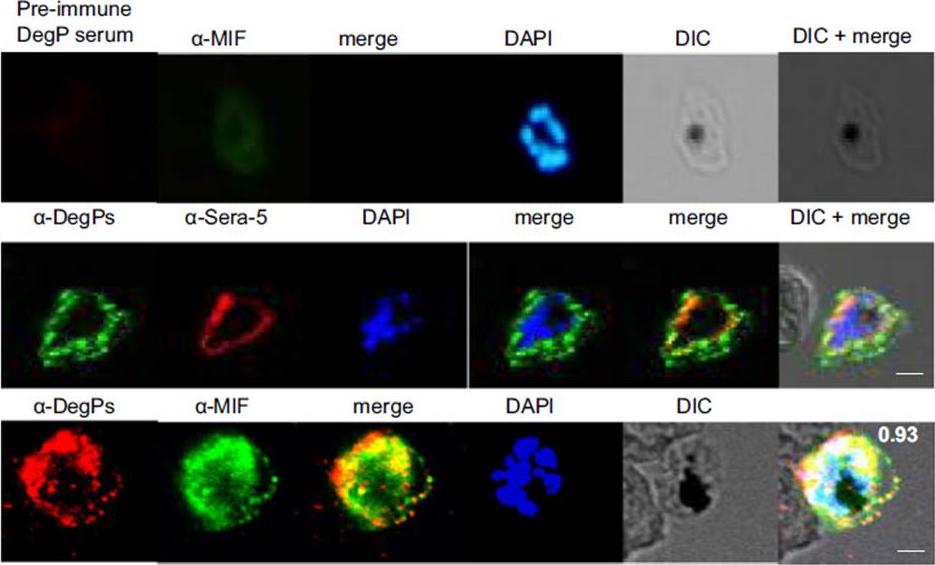PF3D7_0807700 serine protease DegP (DegP)
Disruptability [+]
| Species | Disruptability | Reference | Submitter |
|---|---|---|---|
| P. falciparum 3D7 |
Possible |
USF piggyBac screen (Insert. mut.) | USF PiggyBac Screen |
| P. falciparum 3D7 |
Possible |
https://www.biorxiv.org/content/biorxiv/early/2019/08/28/746974.full.pdf
Decreased sensitivity to dihydroartemisinin. Lower levels of free heme in trophozoites. |
Theo Sanderson, Francis Crick Institute |
Mutant phenotypes [+]
| Species | Stage | Phenotype | Reference | Submitter |
|---|---|---|---|---|
| P. falciparum 3D7 | Asexual |
Difference from wild-type |
https://www.biorxiv.org/content/biorxiv/early/2019/08/28/746974.full.pdf
Decreased sensitivity to dihydroartemisinin. Lower levels of free heme in trophozoites. |
Theo Sanderson, Francis Crick Institute |
Imaging data (from Malaria Metabolic Pathways)

PfDegP exists in a multimeric complex, and is associated with parasite proteins Hsp70 and Eno. Parasites were stained with anti-DegP and anti-Hsp70 (B) or anti-Eno (C) antiserum; parasite nuclei were stained with 4′,6-diamidino-2-phenylindole (DAPI). Fluorescence signals from DegP and Hsp70 or Eno antibodies showed significant merging, with a co-localization coefficient > 0.80.Sharma S, Jadli M, Singh A, Arora K, Malhotra P. A secretory multifunctional serine protease, DegP of Plasmodium falciparum, plays an important role in thermo-oxidative stress, parasite growth and development. FEBS J. 2014 Mar;281(6):1679-99.
See original on MMP
Indirect immunofluorescence assay and confocal microscopy of late stages of P. falciparum-infected erythrocytes and free merozoites. P. falciparum parasites were probed using rat anti-DegP antibody followed by fluorescein isothiocyanate-conjugated anti-rat IgG (green). Other marker proteins were stained with the rabbit antiserum/ antibody followed by Cy3-conjugated anti-rabbit IgG (red). The parasite nuclei were counterstained with 4′,6-diamidino-2-phenylindole (DAPI) (blue), and slides were visualized using a confocal laser scanning microscope. z-section of late-stage parasites stained for DegP showed green fluorescence signals in the cytosol of the parasite and the cytosol and membrane of infected RBCs (Ci). DegP signals were observed on free merozoites (Cii). The surface localization of PfDegP in infected RBCs was confirmed by co-localization with an erythrocyte membrane marker (red) (Di). Yellow spots indicate merged fluorescent signals from DegP and band 3 antibodies (Dii). SERA5 and MIF were used as markers for parasitophorous vacuole and secretory protein in the culture supernatant, respectively. Sharma S, Jadli M, Singh A, Arora K, Malhotra P. A secretory multifunctional serine protease, DegP of Plasmodium falciparum, plays an important role in thermo-oxidative stress, parasite growth and development. FEBS J. 2014 Mar;281(6):1679-99.
See original on MMP
Indirect immunofluorescence assay and confocal microscopy of late stages of P. falciparum-infected erythrocytes and free merozoites. P. falciparum parasites were probed using rat anti-DegP antibody followed by fluorescein isothiocyanate-conjugated anti-rat IgG (green). Other marker proteins were stained with the rabbit antiserum/antibody followed by Cy3-conjugated anti-rabbit IgG (red). PfSera5 and PfMIF were used as markers for parasitophorous vacuole and secretory protein in the culture supernatant, respectively. Significant merging of the fluorescent signal for DegP was observed with SERA5 and MIF signals, indicating the presence of DegP in the cytosol of infected RBCs.Sharma S, Jadli M, Singh A, Arora K, Malhotra P. A secretory multifunctional serine protease, DegP of Plasmodium falciparum, plays an important role in thermo-oxidative stress, parasite growth and development. FEBS J. 2014 281(6):1679-99.
See original on MMPMore information
| PlasmoDB | PF3D7_0807700 |
| GeneDB | PF3D7_0807700 |
| Malaria Metabolic Pathways | Localisation images Pathways mapped to |
| Previous ID(s) | MAL8P1.126 |
| Orthologs | PVP01_0112700 , PVX_088155 |
| Google Scholar | Search for all mentions of this gene |